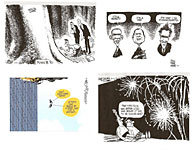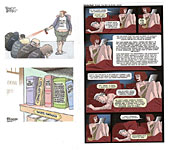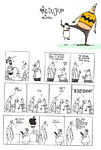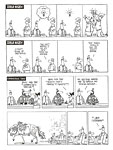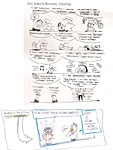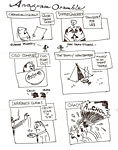 |
|||||||||||
| Opus 296 (July 12, 2012). Approaching the end
of Open Access Month here at Rancid Raves, we post this time an essay on sexual
assault in the military by Doonesbury’s Garry Trudeau and report
on a near sexual encounter in Luann, plus reviews of Mike Lester’s new comic strip (the only new comic strip this year), the Crumbs’ Drawn
Together, Allan Holtz’s encyclopedic American Newspaper Comics and the first
issues of Hardcore and Harbringer. Until August 1, you can read it
all—including the massive R&R Archives and all of Harv’s Hindsight—without
having a $ubscription. We’ll post a list of this opus’s contents, by department,
in a minute.
But first, this: You've probably noticed the news about wildfires out here in the West. Colorado has had its share: west of Fort Collins, the High Park fire burned 87,000 acres of mountain forest and destroyed 259 homes; just outside of Colorado Springs, the Waldo Canyon fire destroyed 347 homes and burned 80,000 acres of mountain forest. I’m in Denver, so far not threatened by the proximity of a wildfire. We’re also in the midst of a drought. In Weld County, the largest agricultural county in the state and the eighth largest in the nation, hundreds of acres of field corn are dying from lack of water, and farmers are selling off cattle early because of lack of feed and water. The heat wave has exacerbated an otherwise already dry spring: the forests and plains are tinderboxes. The state banned fireworks in the hands of individuals on July 4th. But some people don't get it. Police in Colorado Springs near the Waldo Canyon fire responded to 192 fireworks calls on the Fourth, arrested five people and confiscated six bags of fireworks. Near High Park, where the fire still smoulders, deputies responded to 32 calls—27 for fireworks, five open fires—and issued three tickets. In a nation that elects Grandstanding Obstructionist Pachyderms to high office, I shouldn't be surprised. The good news: a herd of 75 big horn (curly horn) sheep miraculous survived the Waldo Canyon fire. Too bad they can't vote. Now, here’s what’s here this time, in order, by department—:
NOUS R US Stan Lee’s Favorite Comic-Con: Movies or Comics? Trudeau on Sexual Assaults in the Military
EDITOONERY Joel Pett Reports on His China Visit Some of the Best Editoons This Month, So Far
NEWSPAPER COMICS PAGE VIGIL Mike Lester’s New Strip Greg Evans and the Seduction of Luann
JIVEY’S ANAGRAMORAMBLE
BOOK REVIEWS Drawn Together, the Crumbs’ Opus American Newspaper Comics: Allan Holtz’s Encyclopedia
FUNNYBOOK FAN FARE Hardcore, No.1 Harbringer, No.1 Strange Talent of Luther Strode Fatale
How to Reform Congress
Our Motto: It takes all kinds. Live and let live. Wear glasses if you need ’em. But it’s hard to live by this axiom in the Age of Tea Baggers, so we’ve added another motto:.
Seven days without comics makes one weak. (You can’t have too many mottos.)
And our customary reminder: don’t forget to activate the “Bathroom Button” by clicking on the “print friendly version” so you can print off a copy of just this installment for reading later, at your leisure while enthroned. Without further adieu, then, here we go—
NOUS R US A Tiny Bit of All the News That Gives Us Fits
Stan Lee, the world’s foremost cheerleader for comics, says his favorite creation is Spider-Man. “He’s the best loved all over the world,” he told Walter Scott at Parade, “and that makes me very happy.” Lee’s preference is not surprising: the most angst-ridden of Lee’s angst-ridden Marvel creations, Spider-Man has done more to make Lee famous than, say, Thor. Or, even, Iron Man, my favorite when I first joined the marching minions of Marvel fans in the early 1970s. But neither Spider-Man nor Iron Man has a face: neither can show emotion. What kind of superhero is that?
COMIC-CONniptions HERE WE GO AGAIN: Entertainment Weekly’s July 13 issue, the one on the stands the weekend before the Sandy Eggo extravaganza begins, announces on the cover that it includes the Comic-Con Preview, which, indeed it does—if you happen to be a movie fan. Of the 25 pages expended on the so-called “Preview,” 23 are devoted to previews of movies and television shows—to wit: The Walking Dead, Iron Man 3, Pacific Rim, Oz the Great and Powerful, Fringe, The Hobbit, Twilight Saga, Dredd, Resident Evil, Looper, Elysium, Branded, Warm Bodies, Expendables 2, Para Norman, thye Possession, Total Recall, Wreck-it Ralph, Elementary, Sons of Anarchy, Arrow, Teenage Mutant Turtles, Defilance, Spartacus, Revolution, 666 Park Avenue, and something pondering the world “beyond Batman.” For most of these, the connection to comic books and the spandex minions is tenuous: they are “the kind of movie” that comic book fans might enjoy—or, at least, that attendees at the San Diego Comic-Con are likely to dote on, at least for a few minutes. Only 2 (that’s TWO! ) pages of the 25-page “Preview” concern comic books: a page for Marvel’s Avengers books and a page for DC’s Before Watchmen line. That’s it for comics at the Comic-Con according to EW. Nothing about any other comic book publisher’s product—Dark Horse, Image, Oni, IDW, etc. Nothing about the most revolutionary development in funnybook publishing since Frank Miller’s Dark Knight rendition of Batman. But EW is not the solitary sinner in this regard: I haven’t seen any commentary on the revitalizing influence in the last several years of the mini-series—the emergence, nearly unheralded, of comic book titles of an intentionally limited number of issues. Miller’s Dark Knight books may have launched the notion, but it’s been kept alive and vital by such titles as 100 Bullets, and, lately, D.B. Cooper, Fatale, Luther Strode, etc. And Casanova, Lobster Johnson, and Bomb Queen offer several issues under a single subtitle, then cease for a time before resuming with another subtitled sequence. Even the time-honored titles like Batman now run to limited series—ten issues under a single heading; then on to the next limited series. Writers start with a concept, an idea for a story; then they decide how many issues will be necessary to tell that story—and, presto, a new limited series. This development, so little noted in the fan press, has effectively created literary achievement where before there were only endless fist fights. The limited series permits thematic focus on traditional superheroes, a step up the literary ladder— Shazam and the Monster Society of Evil, f’instance. But the device also permits stand-alone novels about characters who not super or costumed—like Bad Medicine, Kick Ass, and the deluge from Ed Brubaker and Sean Phillips—Incognito, Lawless, Coward, Sinner, the afore-mentioned Fatale and so on. These enterprises first appear serially in a given title, as “chapters,” so to speak, of a novel; then after the serial publication is complete, the chapters are re-issued as a single book. A novel. But EW, the bible of pop culture, ignores this achievement. (Wonder if Rolling Stone has noticed?) For EW, the Comic-Con is all movies—films about comic book characters sometimes; otherwise, just about the supernatural to which comic book fans seem inordinately addicted.
LAST YEAR, SOON after the Comic-Con folded its tents and disappeared into the gathering gloom of American politics, Torsten Adair at comicsbeat.com did an analysis of the Con entitled “Perception vs. Reality.” Confronting the persistent complaint of recent years that the Comic-Con was more about movies than about comics, Adair counted the number of program hours offered at the Con. He counted only the panel presentations during the day, not evening events or events at the Marriott hotel next door to the Convention Center. By his tabulation, a startling 51% of the programming was devoted to comic books and their immediate milieu—298 hours (“that’s twelve days and 10 hours if laid end-to-end” he noted). In contrast, “Media,” by which heading Adair included animation, movies and tv, totaled only a third of the programming—just a trifling 190.75 hours (albeit “almost eight days”). In short, the “perception” may be that the Con’s all about Hollywood and celluloid; the “reality” is that it’s more about comic books. Adair rejoiced, but his elation was short-lived: some malcontent suggested that he should consider the size of the audiences at panel presentations, not just the numbers of panels. Thus provoked, he examined the physical space devoted to “Media” programming vs. “Comics” programming. Toting up the square footage of the various meeting rooms, he discovered that 4,100, 423 square feet of meeting space was assigned to “Media” programs; only 1,380,275 square feet to “Comics.” “Media” came out so far ahead because these events were assigned to the largest meeting rooms—in anticipation, no doubt, of the interest among the Con attendees. Seeking a way out of this dilemma, Adair did another count, this time eliminating the three giant meeting rooms. In his adjusted tally, “Comics” came out ahead—1,306,658 square feet vs. “Media’s” 1,162,928 sq ft. “Of course,” he observes, “remove the three-room Media circus, and most of the fanboy furor over Comic-Con vanishes. As do most of the crowds and journalists.” Undaunted, he tried yet another maneuver. This time, he consulted the Convention Center’s chart showing the maximum seating capacities of the meeting rooms. Media panels were assigned to rooms the seating capacities of which totaled 440,108; Comics, merely 226,868. Dropping off the three largest rooms again, the figures swung to Comics again: 218,729 vs. Media’s 133,787. “A rather spectacular difference in possible attendance,” Adair exclaimed (italics, mine). “Fanboys would outnumber mediots 8:5.” But he admits the fallacy in his conclusion: he’s comparing the maximum seating capacities of meeting rooms—the number of chairs in the rooms— not the actual attendance at meetings, the number of people actually seated on those chairs. My Con experience has been that the big rooms—the ones reserved for Media events—are usually jammed; many (if not most) of the Comics panels are, by comparison, sparsely attended. If you attract 50-75 people to a Comics panel, you’ve got a mob. The number of panel presentations on Comics and the way those presentations are assigned to meeting rooms can betray a Comics bias, to be sure. But actual attendance trumps intention. Entertainment Weekly clearly understands this: they know movie “news” sells more magazines than “comics” news. Despite Adair’s painstaking effort, movies and Hollywood are still the most conspicuous at the Con. Programming realities aside, the exhibit hall is overwhelmed by gigantic displays touting movies, not comic books. A couple of years ago, I noticed that the DC booth was all about superhero movies; there were no comic books on display at all. Not one. And that strange phenomenon, I remind you, transpired at the booth of a comic book publisher. We’ll see what happens this year. I’m out there in sunny Sandy Eggo again this year, up to my neck in the milling mob that eddies back and forth through the festivities.
SEXUAL ASSAULT IN THE MILITARY By Garry Trudeau and Loree Sutton Washington Post, June 29, 2012 Garry Trudeau is the creator of the comic strip Doonesbury. Loree Sutton, a retired Army brigadier general, is a psychiatrist and founding director of the Defense Centers of Excellence for Psychological Health and Traumatic Brain Injury. She appears briefly in the film “The Invisible War.” Trudeau has for some years now included in Doonesbury a female military character who was sexually assaulted while on duty in Iraq so his participation in the effort the following article makes is scarcely surprising.
"The officer bragged to his fellow officer friends that he had `bagged' me. I got called up to a major's office, and he charged me with fraternization and adultery." — An active-duty Marine, speaking of her rape, in "The Invisible War"
IF THERE IS A DEFINING THEME in all of the testimony in "The Invisible War," the searing documentary film released this week about military sexual assault, it's betrayal. An estimated 19,000 rapes and sexual assaults took place in the military last year. Every one of them represents a monstrous crime made much worse by the sense of betrayal that accompanied it. That so few victims — just one in seven — report these crimes underscores the utter lack of trust that pervades military culture. This should be deeply alarming to the armed services, which have professed a "zero-tolerance" policy for years — but have little to show for it. Trust is critical to any team endeavor, but in the military it can be the difference between life and death. The idea of "having someone's back" is borrowed from the warrior's real-life lexicon. Without trust, nothing works in the military. And because it is experience that forms trust, if a soldier's experience tells her that she will not receive support and justice if she is attacked from within her ranks, she ceases to be an effective team member and suffers overwhelming personal consequences. You have lost that soldier forever. Multiply her by 19,000, and the impact on overall readiness is profound. The military is about big, bold values, stitched into mottos, drilled into heads. Respect, trust, duty, honor, patriotism — these unambiguous values are evoked without irony. They allow down-range warriors the confidence to roll out of their cots and plunge into the horrific daily demands of their profession. They know that their brothers and sisters have their backs — and that they will take heroic measures to protect them. Consider, then, what it does to the psyche of a soldier when he or she is stalked and attacked by that trusted teammate. The average rapist is a lifetime offender and adept at developing protective coloration. His peers often cannot believe he is capable of such crimes, so the victim is, at best, ignored — especially if the perpetrator is a friend of the superior to whom the victim must report. According to one Defense Department study, 33 percent of victims who don't report say they don't proceed for this reason alone. Twenty-five percent say they don't report because the commander they must report to is the rapist. And when the rapist is a superior — the very person our service members have been trained to trust and obey — it's easy to see why so many victims develop a level of post-traumatic stress disorder far exceeding the impact of war-zone combat. For all these reasons, Defense Secretary Leon Panetta's plan to transfer responsibility from unit commanders to an officer further up the chain of command is only a promising first step. If the Pentagon really means to fix the problem of military assault, it must begin by restoring trust in the system. The many victims who have looked in vain to majors and lieutenant commanders for justice can be forgiven for a little eye-rolling at the suggestion that they will receive it from colonels and captains in the future. There is deep cynicism about any solution that keeps the decision-making within the military installation or unit structure, where old-boy networks still rule and where careers are hardly advanced by reporting and documenting rape within the ranks. In our view, the only credible solution is to create an independent special victims unit completely outside the unit chain of command, under civilian oversight. It should be led by a flag-rank officer who has no stake in the reputation of individual commands but a huge stake in doing the only thing that matters — driving down the rate of sexual assault in the military. Any such office would need to ensure leader accountability for the "gateway behaviors" — bullying, humiliation, scapegoating — that set the conditions for violent assault. Another Defense Department study found that the incidence of rape triples in units that tolerate sexual harassment. This will not be easy, even for an independent authority. The military is both a closed system and a target-rich environment, and a career offender currently has little reason to believe he will be apprehended and punished. Several Navy studies administered anonymously reveal that as many as 15 percent of men have attempted rape or have raped someone before they enlisted — twice the percentage of their age-matched peers. Compounding this reality, men and women who enter the military are more likely to have been abused or sexually assaulted before they enlist, a traumatic experience that places them at greater risk for repeated assault. The military population is thus more likely to assault as well as to be assaulted. Isolated duty stations and its closed system for reporting, investigating and prosecuting crimes have made the military, this country's most trusted government institution, a predator's paradise. To
be clear, the vast majority of rape and sexual assault crimes are committed by
a small minority of service members who relentlessly select, stalk and assault
their prey. Most service members would never commit such a crime. But until
basic trust can be restored to the culture, there is no reason to believe the
Pentagon will ever end the sexual violence that has wreaked such havoc within
the ranks.
Fascinating Footnit. Much of the news retailed in the foregoing segment is culled from articles eventually indexed at rpi.edu/~bulloj/comxbib.html, the Comics Research Bibliography, maintained by Michael Rhode and John Bullough, which covers comic books, comic strips, animation, caricature, cartoons, bandes dessinees and related topics. It also provides links to numerous other sites that delve deeply into cartooning topics. Three other sites laden with cartooning news and lore are Mark Evanier’s povonline.com, Alan Gardner’s DailyCartoonist.com, and Tom Spurgeon’s comicsreporter.com. And then there’s Mike Rhode’s ComicsDC blog, comicsdc.blogspot.com and Michael Cavna at voices.washingtonpost.com./comic-riffs . For delving into the history of our beloved medium, you can’t go wrong by visiting Allan Holtz’s strippersguide.blogspot.com, where Allan regularly posts rare findings from his forays into the vast reaches of newspaper microfilm files hither and yon.
QUOTES AND MOTS “Today’s politicians seem more comfortable invoking God and religion than they do presenting facts or numbers. Of course, everyone is entitled to his or her own religious beliefs. But when science and reason get shortchanged, so does America’s future. ... It’s important to keep an eye on how our political leaders view science and its advances because their attitudes frequently mirror their approaches toward rational decision-making itself.”—Lisa Randall in Time “The greatest threat to civility isn’t the random ‘You lie!’ outburst. More threatening to our firmament is the pandering to ignorance, the elevation of nonsense, and the distribution of false information.”—Kathleen Parker, syndicated newspaper columnist “Reputation, it is said, is about who you are when people are watching; character is about who you are when you are alone in the room. There is a similar duality in modern faith, a tension between faith externalized for public consumption and that which wrestles despair in the midnight hour. Each has its place. But only one will see you through till the morning comes.”—Leonard Pitts, syndicated newspaper columnist par excellance
EDITOONERY Afflicting the Comfortable and Comforting the Afflicted
EDITOONIST JOEL PETT, who draws for the Lexington Herald-Leader and who could double as a stand-up comic, went to China in early June, and he wrote about it in diary fashion. Here are parts of it: Beijing: June 10, 2012. Okay, I know this is alarming to all true patriots, but I am in China for two weeks on a low-level State Department diplomatic mission. By "low level" I mean that I'm pretty sure the current chain of command is Obama>Hillary>me. I'm to give a series of speeches on press freedom, specifically how U.S. cartoonists make relentless yet utterly ineffective mockery of our elected officials, something that cartoonists around the world aren't able to do, at least without risking censorship, incarceration or bodily harm. Since I was never required to serve my country by drone-striking or waterboarding suspected terrorists, or strafing anyone with Agent Orange, it seems the least I can do is talk about political cartoons. More on that as the trip progresses. For today, my primary charge is to stay awake long enough to adjust to the time difference, which I plan to do by exercising, then drinking beer. I think I'm on the precise opposite side of the earth ... not sure it matters what direction you go from Chicago ... just take off and go straight for 14 hours, go down through the smog and you're in Beijing. ... Spectacular airport, rebuilt for the Olympics a few years ago. Very happy to see the guy with my name on his sign. My embassy driver didn't speak a word of English. I can't believe it—almost everyone in Lexington speaks pretty decent Chinese … Xian, July 11. Xian is a tidy little hamlet of a mere 9 million. ... My briefing book warned about the traffic in major cities. China has the highest accident death rate in the world. There are apparently no rules, and every imaginable type of vehicle swarms in all directions, most handily equipped with horns but no signals. Speed limits, lane delineations, and even one-way signs are considered helpful suggestions, not so much hard-and-fast rules. I've been in it plenty of times in my life, but I'm always convinced my driver is about to kill an elderly pedestrian, or maybe an entire family of four on a bicycle, thus inconveniencing me, since I'm pretty sure it's customary to attend the funerals, and bring gifts, such as tea servings and decorative fans. I spoke last night to some Chinese cartoonists, and some of the staff of China's largest business publication, Chinese Business View. Counting the dinner, the set-up, the presentation, the questions, the gift-giving, and the tour, it worked out to nearly six hours. My speeches are aided immensely by the need to pause every 10 seconds for translation, although I now know Chinese for such crucial phrases as "Superpac donor," "friend of coal" and "Jesse Jackson threatened to cut Obama's nuts off." Xian, June 12. Today I made two more speeches about political cartooning, in my quest to thoroughly perplex the largest number of Chinese possible in a short time. This morning I was driven to an enormous complex of offices at the (drum roll, or egg roll, please…) "Cultural Relics and Replicas Development Co., Ltd." From what I could gather, it's just what it sounds like, a private company that makes phony "relics" on an enormous scale. After all, if historic artifacts are a good thing, brand new relics are clearly way better, and a lot less dusty and cracked. Perhaps you yourself might purchase one in the near future and proudly display it in your personal home, next to your civil-war replica weaponry. CRRDC is also developing what seemed to be a frighteningly immense theme park, scheduled to open in 2015. ... If it flops, maybe it could just be re-branded as a "relic" theme park. My guess is that it will have a Great Wall that is Greater than the current so-called Great Wall, which is broken down in places, clearly past it's prime, and so uneven you could twist an ankle or break a heel. Just to be helpful, I suggested what I thought an appropriate exhibit combining faux-relic buildings with a Chinese dietary staple, with the palindromic name "A dog! A panic in a pagoda!" The smiling officials appeared perplexed. I'm guessing it won't happen. The second talk was at the People's Ginormous University of Officially Approved Journalism, a classroom of a couple hundred attentive and cheerful perplexed young people. I was assured the students understood English, but I wasn't so sure, since they didn't laugh uproariously at jokes about Mitch McConnell. I began to suspect it wasn't even a real "university" since they don't even have a basketball team. Shanghai, June 14. The Shanghai schedule has been packed with EXTREMELY IMPORTANT diplomatic activities. After meeting the consulate staff yesterday morning, I was interviewed by a young Chinese newspaper reporter. He spoke beautiful English and asked very intelligent questions about such topics as the Danish cartoonists drawing Muhammad, the upcoming U.S. election, and why I have nothing nice to say about the Chinese in my cartoons. I explained that editorial cartoons generally have nothing nice to say about anyone, and reminded him that criticism of their government doesn't necessarily translate to negative ideas about the Chinese people, who seem to be among the kindest and most helpful denizens of the entire planet, unless they are faking it as part of a communist plot to lull us into borrowing more money from their banks and spending it on Chinese-made consumer electronics. Later I had two more media interviews, a roundtable with some Chinese journalists, and an evening program at Shanghai's most prestigious journalism school. Nearly all the students I met spoke English, and were headed for graduate work in the U.S. Again, a large majority of the journalism students were young women. I entertained an auditorium of 70 or so with cartoons, jokes that defied translation, and live drawings of such familiar Chinese household names as Barack Obama, George W. Bush, and Mitch McConnell. Okay, they don't know McConnell, but I like sharing my drawings of him as an obstructionist moneybag, a turtle, a dinosaur, a cockroach, a cross-dressed hooker and a semen stain on the blue dress of democracy with the largest possible global audience. I'm pretty sure this serves the national interest.
A FEW GOOD ONES WHIPPING THIS
OPUS out on the eve of my departure to that glorious popcult lalapalooza known
worldwide as the Sandy Eggo Con, I find that not much political has transpired
since our last posting on July 2—or, rather, it’s all pretty much the same
schtick everywhere I look; so our sampling of some of the best editoons lately
is brief. Punk is saying: “Ah, arson—the last refuge!” A portion of his remark, the “last refuge” part, alludes to what scoundrels resort to. It was Samuel Johnson who said, “Patriotism is the last refuge of a scoundrel,” and Oliphant has taken the allusion one step further, but the implication is the same: Mitt is a scoundrel. Well, we knew he was a whore, selling himself to anyone who has the price, and now we know the rest of him. Swinging clockwise, we come to Steve Benson’s assessment of the health care decision, which reminds me that Romney the GOPanderer managed to pronounce himself, as usual, on both sides of the Decision. The Supreme Decision establishes the Obamacare’s individual mandate as a tax, he uttered; but because he never wants to be in favor of a tax, he declared Romneycare in Massachusetts a penalty—even though the two mandates are virtually indistinguishable! But if the mandate is a penalty, saith the Supremes, it’s unconstitutional. No matter: whatever you say, Mitt—this is the Age of the Big Lie, so whatever the Revered Candidate says must be true. If, that is, he says it often enough. That’s the technique of the Big Lie, the technique of the Grandstanding Obstructionist Pachyderm these days. This guy Romney is a genuine imitation if ever there was one. C’mon, Mitt: the endless repetitions of the Big Lie might convince me that black is white, but it cannot declare white to be black while at the same time being both black and white. The first is a triumph of repetition over reason; but the second is an offense to logic. Finally, at the right, we have Mike Luckovich’s comment on Justice Scalia’s temper tantrum when the Supreme Decision didn’t go his way. A persuasive blend of word and picture. With the next cartoon at the lower left, we transition to a different category of editoon altogether—namely, those I culled from the website forums.somethingwful.com. Although as you may have noticed, I’m not a big fan of conservative thought, Mike Lester, who is, is also a stunningly funny editoonist, and I always admire his craft as well as his sense of the ridiculous (i.e., political so-called thought) even when I don’t agree with the point of view being indulged—as in the case of the last of our cartoons in the first visual aid. This effort appeared months ago (maybe years ago) when the idea of building a mosque near Ground Zero was being hotly albeit ignorantly debated. Lester makes his point with unflinching precision—one of the best editorial cartoons of the time (on any subject). Lester has since left the Rome (Georgia) News Tribune and is now launching a comic strip, which we’ll preview in the Vigil segment down the scroll. Meanwhile,
we resume a glimpse of the sort of visual shenanigan you might find at
forums.somethingawful with our next exhibit. Next on the clock, Chris Muir delves tellingly into the battleground of the sexes, but I’m hard-pressed to say whether he declares victory on one side or the other. Nicely done. Finally, at the lower left, Ben Sargent lines up works of fantasy to blow up the contention that an armed populace is safer than an unarmed one. Ooops.
I was probably wrong about Glen McCoy: I think it’s his twin brother Gary whose right-wing-nut cartoons I can barely understand. Here’s one, f’instance,
at the upper left. No such problem at two o-clock with Daryl Cagle’s scatological comment on the House voting, as it has repeatedly over the last few years, to repeal Obamacare. The image is striking and adequately conveys the impression that the vote is meaningless—for shit, in the vernacular. (Incidentally, Cagle is also proprietor of CagleCartoons, the website marketeer syndicating packages of editoons all around the land.) The current vote to repeal Obamacare is the 33rd such GOP attempt to “roll back” the health care reform law. None of the previous bills ever made it to the Senate, which, controlled by Democrats, refuses to take up the matter. So why bother in the House? Cosmetics. Appearances. Appeasing the Tea-Baggers. I can hear the shrill whine of Teabag protest even now: “Ain’t no government gonna deprive me of my God-given Constitutionally guaranteed rights to get sick and die because I can’t pay for medical care.” Won’t happen: we’ll all pay the guy’s bills because it’s required by law. But the whine is a cheer that appeals to the Tea-Baggers and others of the Pachyderm persuasion who want to “roll back” all the way to the 18th century. The GOP says it will replace Obamacare with something just as good but less offensive to their socialist fears. What? Have they told us what the “new” revised health care reform would be? Nope. They’re good at yelling and rolling back into previous centuries, but they apparently have given no thought to the future. Pat Bagley’s wry notation on the discovery of the “God particle” is good for a laugh, and that’s all he intends. I’ve included at the lower left Brian Duffy’s cartoon about bullying because it speaks to the powerful impact editorial cartooning can have. The cartoon appeared last spring, April 22, on the front page of the Sioux City Journal accompanying a full-page editorial denouncing bullying after a 14-year-old boy committed suicide the week before because he was harassed for being gay. That, the latter, is an old story by now: too many gay kids are being bullied when they come out of the closet. But the former, the front page play of an editorial cartoon, is a new story, and it proclaims unequivocally that editorial cartoons have great impact.
CIVILIZATION’S LAST OUTPOST One of a kind beats everything. —Dennis Miller adv. The Associated Press reported that “the Fourth of July fireworks show went off with a bang over San Diego Bay. ... the Big Bay Boom show that was supposed to wow crowds for 20 minutes lasted only about 20 seconds.” A computer malfunction set off tens of thousands of fireworks on four barges. Computer malfunction. You realize, of course, how much of our civilization is controlled by computers? The so-called “news” media have lately been discussing the possibility that some Foreign Power will wreak havoc in the U.S. by sabotaging computers. Or—to deploy another Doom’s Day scenario—maybe huge quantities of computers will simply malfunction and send us back to the Stone Age.
NEWSPAPER COMICS PAGE VIGIL The Bump and Grind of Daily Stripping AT EDITOR & PUBLISHER, comics correspondent Rob Tornoe pronounced in the July issue on the tenuous state syndication: “The syndication business has seen many ups and downs in its more than 150-year history, but at no other point have the stakes been greater, and the waters choppier, than they are today. The Internet—and subsequent diversification of news sources—not only threatens the traditional business of newspapers, but is also cause for concern for the national syndicates that have developed a business model of supplying those newspapers with content to fill their pages. Nowhere else is this shift more evident than in the development of new comic strips, which have long been one of the primary sources of revenue for syndicates. In years past, syndicate companies would have in production many new strips to offer, but this year, only one syndicate, Washington Post News Media Services (WPNMS) is launching a new strip.” And that strip is Mike Lester’s Mike du Jour. After leaving the Rome News-Tribune (the smallest circulation daily newspaper to have a full-time staff editorial cartoonist), Lester went into syndication with Cagle Cartoons. Then he decided, Tornoe explains, to switch to WPNMS “in part to participate financially in the success or failure of his work: Cagle Cartoons produces a package of cartoons for newspaper clients but WPNMS represents cartoonists individually” so Lester would take home a bigger piece of what his editoons earn instead of sharing revenue with others in a package. And then WPNMS picked up Lester’s comic strip. “Mike du Jour has been in my studio for years,” Lester told Tornoe. “To be honest, I never dreamt of having a comic strip, so it’s never been a goal long-term or otherwise. It’s only taken over my life in the last couple of years.” Editooning isn’t Lester’s only cartooning gig. He also illustrates (and sometimes writes) children’s books, other books, and magazine articles. Amy Lago, WPNMS’s comics editor, has had discussions with Lester about the strip many times over the years, and she’s excited about Mike du Jour. “To me, this feature is different,” she said. “It looks different, and its voice is different. It’s also laugh-out-loud funny, which rarely happens, and accessible to readers of all ages.” The genesis of the strip, Lago writes in the WPNMS news release, was unusual. “One day Mike got a phone call from Ezra Palmer at WSJ.com asking if he could do business gags and animate them. ‘I could not,’ Lester explained, ‘so I said, Of course I can,’ and then started reading the Wall Street Journal and learning basisc animation.’ He and Palmer named the animation Mike du Jour.” And the animated feature eventually morphed into a daily comic strip of the static variety. “Mike du Jour is, according to Lester, the rare triple entendre: the main character’s name, the artist’s own name, and an honest description of the strip. ‘Like the freedom of a chef designing a menu every day based on what’s fresh, MdJ is whatever fresh idea I can cook up,” said Lester. “You’ll never know what tasty bon mot you’re going to get.” The title character works in an office, but the strip is not an office strip. It’s about everything, including bad puns. “Mike is at once observer and victim of his life,” saith the sales kit write-up. “You might call it immersion journalism. Mike calls it a dry vodka martini without the olive or vermouth. But never without the vodka.” Mike has a pet dog named Minnie, who “can be counted on to tell Mike the truth.” And at the office, “Backwaks is Mike’s boss at Big Bottom Line Inc. He is loud. He wears a rug (wig) that resembles his mom’s old fox wrap. He’s a poor judge of character, is readily swayed by fads and fluff, and yet he’s somehow a successful businessman. The exception that proves the Peter Principle.” Another character, whom we encounter with Mike at the coffee bar in the first strip of our visual aid, is Picasso, who, “like great art (or a halibut), has both of his eyes on one side of his head. He is insecure, a little shy, and easily hypnotized by shiny objects and infomercials.” Here are some strips from the sales kit, an unerring indication of what happens when a cartoonist cuts himself free from everything but whatever seems fresh on his drawing board in the morning.
Lester’s weedy drawing style seems perfectly suited to the backyard garden in which his ideas seem to sprout without bidding.
ELSEWHERE ON
THE COMICS PAGES, we find Greg Evans tempting fate by depicting his
eponymous Luann on the cusp of seduction by her non-boyfriend Gill, the
handsome hunk temporarily in the U.S. from his native Australia. Yes, Gill’s dad is phoning to tell him they’re going back to Australia. Luann and Gill, although obviously attracted to each other, vowed upon meeting that their relationship would be platonic rather than romantic—in order to make the inevitable moment of parting less painful, as Gill remembers the day after our last example here. “Well, it’s not working!” screams Luann. Evans, as is his wont, concludes the risque episode without crossing that line, another of his numerous exercises of good taste and comedic sense, particularly when dealing with matters of the heart. The episode in Luann’s bedroom ends with them kissing goodbye. And when they talk on the phone just before Gill is to leave town, Luann asks if she’ll ever see him again. “Only in your passionate dreams,” says Gill. To which Luann says with a smile: “I’m already starting to miss you less,” the kind of bantering exchange that has distinguished their relationship all along. Nicely done. Not everyone agrees, of course, and the episode inspired the usual smattering of pro and con comment. When I asked him about the reaction among readers, Evans wrote: “Lots of comments at GoComics along the lines of ‘Quill-Is-Leaving-OMG-Why-Can't-You-Let-Luann-Have-A-Boyfriend-For-Once?!’ The scene on the bed thrilled some, worried others. Everyone wants relationships to go on, but as a comic stripper, I'm faced with the Elephant In The Room: sex. My characters are 18. Where do I go with their romances? Keep treading water with chaste kisses forever? Something has to happen. Anyway, it continues to amuse me how some commentators assume that whatever I've done in any day's strip is final and they can deduce exactly what's going to happen now. Sometimes, they're right. Most times, they're wrong. I have plans for Luann and Quill ...” In
our next exhibit, we see Dagwood at the barber shop, where we see him every
other week or so. After the barber shop, we see Dagwood at the returns desk, an unusual strip for Blondie: it’s one panel. The physical dimension underscores the sound of snoring that dominates the strip, a useful dodge; and it is also an example of something that has been happening in Blondie every so often: namely, a violation of the erstwhile undeviating 4-panel pattern that has distinguished the strip for several generations. Nice to see a little diversity, especially when it serves the gag. Dilbert is here because it amused me more than usual. The mental picture is hilarious. And Mother Goose and Grim secured its place in this posting because of its subliminal reference to dogs’ leg-lifting proclivities. About Which There Will Be More Later: Patrick McDonnell is taking Mutts to the Comic-Con this week, with the characters in superhero costumes. And Hector Cantu and Carlos Castellanos feature a couple overt Con references in Baldo. I’ll include samples with my post-Con report next time.
JIVEY’S ANAGRAMORAMA Playing With Words and Pictures HEREWITH, one of our periodic visits to Jim Ivey’s Anagramorama.
In the first of these, Ivey explains his compulsion; in the next three, he indulges his compulsion, ending with one that has the distinct aroma of a political cartoon, at which trade Ivey plied for decades before becoming a beachcomber. Jim Ivey’s Sunday Comics, by the way, is a feature at Allan Holtz’s website, strippersguide.blogspot.com, by which you’ll realize just how incestuous Rancid Raves can be when you get to the book review below.
PERSIFLAGE AND FURBELOWS “If evolution really works, how come mothers only have two hands?”—Milton Berle “Though familiarity may not breed contempt, it take the edge off admiration.”—William Hazlitt
BOOK REVIEWS Critiques & Crotchets
Drawn Together By Aline and R. Crumb 264 8.5x11-inch pages, b/w and color; Liveright/Norton hardcover, $29.95 IF YOU CAN CONTROL YOUR GAG REFLEX at witnessing the cringe-worthy cartooning of Robert Crumb’s wife, Aline Kominsky, then you can observe one of the artform’s most peculiar productions—namely, autobiographic comic strips written and drawn by the husband-wife team, he drawing himself, she drawing herself. Until this book arrived in the mail the other day, I’d never been able to overcome my revulsion at Aline’s ugly art long enough to read any of their collaborations. This time, I forced myself and discovered a dubious albeit esoteric pleasure. The strips are of the slice-of-life variety, but the slices are decidedly libido-ridden. Aline’s portions of the narratives are all about her; she is self-absorbed and vain. In Robert’s parts, he natters on about life’s inconsequential trivia (“I hate swallowing these vitamins; I hope they actually do some good”) between bouts of violent sex with Aline (or with himself). Or else he’s demanding that she prepare meals for him.
In an Introduction written as if it were a conversation between them—he writing his parts; she, hers—Crumb marvels that out of a total world population of six-and-a-half billion, he and Aline are the only couple producing comics in tandem. Says Aline: “I guess we’re unique geniuses or something.” Unique, I guess. For several hundred years I couldn’t imagine how Robert, a supremely talented cartoonist, could permit his work to appear on the same pages as his wife’s execrable scrawling. Has he no self-respect? I wondered. Was he simply permitting her to have a “cartooning” career by hitchhiking on his since she clearly could not summon one of her own on the basis of her ability? I was at a loss to explain this phenomenon. And then, I remembered Charles Crumb. The comics Aline and Robert produce are not, in Robert’s experience, unique. The method, in fact, is an encore of what he did in his childhood. He and his older brother Charles very early discovered a common interest in comic books, and they began writing and drawing their own single-copy comics, imitating the animal characters they found in Walt Disney’s Comics & Stories (Carl Barks’ ducks), Dell’s Animal Comics (Walt Kelly’s screechers), New Funnies (with Andy Panda), and Terrytoons (Mighty Mouse, and Heckle and Jeckle). Their method in creating what they called “two-man comics” was unique: they worked together, progressing from panel to panel, each drawing and dialoguing his own character, to which the other made his characters respond. Charles committed suicide years ago. In Aline, Robert found a comics soul-mate capable of doing what Charles had done. And so, together, they create comics by causing their autobiographical characters to interact on the page in much the same way as they themselves interact in life. Or so we are persuaded by the pages before us. Aline can write dialogue in response to Robert’s, or in counterpoint to it—like Charles did, I assume; but she still can’t draw for shit. Their “two-headed” comics, however, are not, strictly speaking, autobiographical. They are not accurate self-portraits: Robert and Aline have created caricatures of themselves, comic book characters, who enact the personas the two have invented—Robert the maniac sex machine, Aline the vain and self-centered female of the species. To appreciate the product of their enterprise, we must suppress the gag reflex at Aline’s gawdawful drawings and focus instead on how the two characters interact: in their interaction is the essence of these comics—not the narrative, not the “story,” not the personalities of the principals, but the way the tale is woven from how the characters are behaving with each other. This tome is the only complete collection of the husband-and-wife collaboration since it began in 1972. The publisher assures us that this volume contains all that they’ve done together—the complete Dirty Laundry Comics from the 1970s and 1980s, the collected Self-Loathing Comics (which documents the Crumbs’ exodus to France in the 1990s), all their color strips for The New Yorker (reporting on the Cannes Film Festival and New York’s Fashion Week and other cultural hot spots). Also included is a 16-page sequence about “A Day in the Life” of Crumb (drawn entirely by Robert) and another with the same title drawn entirely by Aline. (I read Robert’s story with pleasure; I couldn’t bear to look at Aline’s drawings long enough to read hers. Sorry.) In one story, an unprecedented novelty—Art Spiegelman appears in self-portrait; ditto Charles Burns and Pete Poplaski, all as minor characters in the Aline-Robert drama. (Poplaski plays the part of Zoro, costumed and sworded.) One story, “Senior Sex,” new and original for this collection, convincingly reveals that people as old as Robert and Aline fornicate in sometimes rigorous ways. (As we edge up to obscenity and then back away, I am delighted to report that there are fifteen hundred words for copulation and a thousand each for penis and vagina. So if you’re unhappy with fornication, look around for a substitute.) As Robert Weil, Liveright editor, says: “If anyone in the future will want to remember the Crumbs, this is surely the book that will show what they were all about.” As long as you remember that the characters who appear on these pages are comic characters, caricatures, of the people who draw them and write their speeches. Otherwise you’ll have a bizarre idea of what Aline and R. Crumb are actually like. (Or maybe not.)
American Newspaper Comics: An Encyclopedic Reference Guide By Allan Holtz 624 8x11-inch pages, b/w; U. of Michigan Press hardcover, $150 AS I SAID LAST TIME, this long-awaited tome is the ninth wonder of the world. (Well, I didn’t say that, exactly—the ninth wonder—but I say it now and could have said it then.) I could rave about the as-yet unseen book because I know Holtz and his work and know it to be the most meticulously assembled data on newspaper comics around. The publisher sent me a review copy that arrived a couple days after we posted Opus 295, and so now I have the Actual Edifice in hand, and it lives up to its hype—and more. Twenty years in the painstaking making, listing over 7,000 different newspaper comic strip and cartoon features, Holtz’s life’s work is undeniably The Authoritative Source of basic data about newspaper comics. Each entry includes start and end dates of the feature, format, frequency, names of creators and distribution syndicate, and the source of the information. At the end of the book, a directory of syndicates musters them all, providing founding dates and short histories; then an index of syndicates lists all the cartoon features distributed by each syndicate. An index of credits lines up cartoonists alphabetically and then names the features each created. Another section lists the published collections of comics, followed by a Title Cross-Reference that connects alternative titles to the copyrighted one—Jiggs and Maggie, for instance, is a colloquial title for Bringing Up Father. The book is almost solid type. The illustrations are carried in the CD that accompanies the book: it includes b/w and color samples of over 3,000 comics. In the body of each entry in the volume, symbols indicate whether that feature has been reprinted in a collection and if the feature is represented on the CD. By way of demonstrating how the Guide works, we’ve mustered the data on Zeus, a short-lived daily and Sunday strip in 1979.
The adjacent visual aid starts with the spread sheet that was Holtz’s first version of the entry; next, a copy of the page from the book, showing how the data was re-formatted from spread sheet to paragraph. Finally, the sample strip from the CD. Note at the end of the book entry, three symbols: the first, a tiny opened book, indicates that Zeus strips have been reprinted in a collection (which, A Book of Zeus, is listed in the Published Collections section of the book); the second, a disk, shows that a sample of the strip appears in the CD; the third, a tiny magnifying glass, tells us that an article about Zeus can be found at Holtz’s website, strippersguide.blogspot.com, which Holtz has maintained since 2005, adding new content daily. Although the entries do not describe the storyline or theme of the strips (Terry and the Pirates is not described as a continuity adventure strip set in the Far East, for instance; nor is Beetle Bailey dubbed a humorous joke-a-day strip about life in the army), some entries include fascinating notes. About Jeanie, for example, a Gill Fox creation running for only two years, 1951-53, Holtz writes: “This is one of the many strips used as fillers in the NY Herald-Tribune’s Sunday sections. These strips were all sixth page format and would fill in the empty space left over when the paper would run a half-page and third-page feature on a page (typically the third- page was an ad). These fillers were used from 1942 to 1956. No title ran every week—they were used strictly on an as-needed basis. They are sometimes mistaken to be toppers, but they are not associated with a regular Sunday strip. It is not believed that any of these fillers was ever syndicated to other papers. This filler [Jeanie] graduated to a regular feature in 1952.” More than you want to know about an obscure strip, maybe, but indicative of the care and attention to detail Holtz exercises throughout. The Brick Bradford entry goes on for one-and-a-half pages because Holtz lists the titles and running dates of stories from August 1933, when the strip began, to the end in May 1987, dailies and Sundays. But this kind of excess is unusual. Throughout the book, Holtz gives the names of those who ghosted various strips, relying, often, upon the expertise of Alberto Becattini, who discusses his methods and rationales in an essay reprinted in Holtz’s exacting and essential Introduction. Probably not every American newspaper comic strip ever published is listed herein. The prospect is vast, hundreds of papers and thousands of comics features. Holtz must’ve missed a few. I know of one such possibility, The Muddleups by Wally Wallgren, World War I’s soldier cartoonist who virtually disappeared into civilian life after a military cartooning career in which he achieved rock star status. The Muddleups is described briefly in Harv’s Hindsight for February 2009: the strip was about married life, but the material was clearly not Wallgren’s forte: distributed by Dan Sowers Syndicate, the strip could not have lasted more than a few months. It may, in fact, never have been picked up by a newspaper: in its September 11, 1937 issue, Editor & Publisher announced the strip’s scheduled debut for October 18, but Holtz says he was unable to find it in any newspaper. But Wally tried again the next October with a more congenial subject: Hoosegow Herman was about a soldier in the peacetime Army, and for it, Wally drew again upon his WWI experience, drafting as characters fellow staffers on the Stars and Stripes. Holtz includes Herman, and supplies information I was missing—the running dates of the strip: October 10, 1938 - June 13, 1940, but for only a portion of that time was Wally producing new material. Holtz notes: “Wallgren was fired for missing deadlines, so original material ended in 1939; the strip continued to be available in reprints through June 13, 1940.” Holtz also lists Willie Dee, a favorite strip of my youth by Vic Green, which I’ve never seen referenced anywhere else. Bravo. Holtz may miss a few, but, as he says at the end of his copiously informative Introduction: “Like fleas on a dog’s back, question marks infest these listings, indicating bits of information not yet known. As with most pests, it’s impossible to get rid of every single one, but that doesn’t stop me from trying. The research work for this project shall go on, quite likely until I drop dead—preferably in a library, slumped over a microfilm viewer in the act of rewinding a particularly informative reel.” As you can see, Holtz is not only a storehouse of information, he’s fun to read. And accurate. You’d have to prove him wrong, and it wouldn’t be easy.
Read and Relish Department of sleeping cows and horses. Both cows and horses sometimes lie down and maybe sleep. But the lying down is the part we’re pondering here. When they get up, cows get up on the hind legs first; horses, on the front legs first. Or vice versa. The point is, why do these four-legged creatures arise differently at all?
FUNNYBOOK FAN FARE Four-color Frolics An admirable first issue must, above all else, contain such matter as will compel a reader to buy the second issue. At the same time, while provoking curiosity through mysteriousness, a good first issue must avoid being so mysterious as to be cryptic or incomprehensible. And, thirdly, it should introduce the title’s principals, preferably in a way that makes us care about them. Fourth, a first issue should include a complete “episode”—that is, something should happen, a crisis of some kind, which is resolved by the end of the issue, without, at the same time, detracting from the cliffhanger aspect of the effort that will compel us to buy the next issue.
Hardcore No.1 sets up an intriguing premise. One of those ubiquitous scientific advancements enables a trained agent to occupy the body of another person, usually for the purpose of assassinating another, undesirable, personage, which can be done out in the open without fear of retaliation: although the occupied body is likely to be killed, the agent can flee the premises without difficulty—provided he does it within 72 hours of his initial entry into the body. The device by which an agent enters the body of another is called hardcore. The issue’s completed episode sends Agent Drake off on a mission, which he successfully completes, demonstrating his skill. Next, he meets a representative of the Department of Defense, who he briefs with wit and precision on how hardcore works (a nifty expository maneuver that scarcely interrupts the story). Next, we meet the man who Drake has replaced, Marcus, who infiltrates the next operation Drake is sent on, upsetting the mechanism and threatening to leave Drake in his current incarnation beyond the prescribed 72 hours, thus condemning him to death. End of issue. We like Drake’s wit and his courage, and so we don’t want him to die. And we’ll therefore return to cheer him on. It’s Robert Kirkman’s story, ably and crisply drawn by Brian Stelfreeze,
whose clear, bold linear artwork is sprinkled with intriguing flicks of the
pen, enough to declare an individual mannerism. The storytelling is above
competence, a pleasure to witness. The opening sequence, which transpires
without our knowing what hardcore is, is a little puzzling; but the subsequent
explanation clears it all up.
VALIANT’S second offering, Harbringer, leaves me a little cold—but that’s because I don’t much enjoy stories of psychic phenomena. The Harbringer is an Asian named Toyo Harada, a psiot, who has the ability to make things happen with his mind alone. He has been waiting to enlist the help of an American kid named Peter Stanchek, another psiot, who is troubled by his mysterious ability, which, so far—in this issue—he deploys to get a girl he likes to fall in love with him and go to bed with him, the issue’s completed episode (which doesn’t display Peter in a particularly admirable light). With his buddy Joe Irons, Peter is on the run from some previous but as yet unspecified offense; Joe is arrested, and he’s visited while in jail by a menacing know-it-all, who apparently arranges for Joe’s release, and Joe, trying to rejoin Peter, leads the police to where Peter is. By then, Toyo Harada has had a conversation with Peter, suggesting great things in store. But neither one of these protagonists is very attractive as a personality; I could care less what happens to them, and so I won’t be back to find out what transpires next.
SHORT SNORTS The Strange Talent of Luther Strode, which I’m up to No. 2 with, is apparently about a put-upon highschool kid acquiring superpowers that he then deploys to get back at a campus bully. Decent storytelling by writer Justin Jordan and artist Tradd Moore, who draws with a slender, unvarying line that often clutters pictures with too much detail. The drawing, alas, doesn’t attract me, and the story seems adolescent. Ed Brubaker and Sean Phillips’ Fatale is up to No. 5 now, marking the end of Book One. It deviates from the straight crime story mode that the two have engaged in up to now: this is spooky stuff, which, as I said, I don’t normally like. But Brubaker clothes the mysteriousness of Josephine’s multiple lives (dogged by vicious other-worldly sorts) in enough realistic raiment to keep me interested. The protagonist and Jo, his paramour, are given recognizable human qualities, and that raises the whole enterprise above the usual spook story.
ONWARD, THE SPREADING PUNDITRY The Thing of It Is ... HAVE YOU CAUGHT the Ken doll candidate’s campaign symbol? That sort of double R, white on a red field. The reflective nature of the double-R suggests Romney’s pandering political posture, which is first one, then the other—whichever is convenient (or appealing) at the moment. The double-R is the perfect symbol for Orwellian doublespeak. And Romney’s got it. But more than that, his symbol is an outright steal from Ramada Inns. He’s using their double-R. I guess that makes him the roadside inn candidate.
COMES THE REFORMATION A friend sent me the specifics set forth below for reforming Congress. The recommended steps seem to me to tackle and remove most of the present impediments to effective government in this heppy heppy land. Capitalism is probably the best way to organize human society: capitalism works well because it depends upon a fundamental aspect of human nature, greed. A capitalistic society like ours is inevitably a plutocracy in which government is conducted by or for the wealthy. But a plutocracy need not also be an oligarchy, government by the few. Over the years, we have participated in the charade of the oligarches, who have cleverly convinced us that our form of government is a democracy. It is time to reject this figment, destroy the oligarchy, and reclaim some semblance of the democracy we all think we’re living in. And we can do it with a simple series of laws, that we call here—:
CONGRESSIONAL REFORM ACT OF 2011
With actions like the following, we can reform our government.
1. Term Limits 12 years only, one of the possible options below: a. Two Six-year Senate terms b. Six Two-year House terms c. One Six-year Senate term and three Two-Year House terms
2. No Tenure / No Pension A Congressman/woman collects a salary while in office and receives no pay when out of office. Serving in Congress is an honor, not a career. The Founding Fathers envisioned citizen legislators, so ours should serve their term(s), then go home and get back to work at some useful occupation.
3. Congress (past, present & future) participates in Social Security All monies in the Congressional retirement fund should be moved to the Social Security system immediately. All future funds intended for this purpose must flow into the Social Security system, and Congressmen/women participate in the system just as the rest of the population does.
4. Congresspersons can purchase their own supplemental retirement plan, just as all Americans do
5. Congresspersons will no longer vote themselves a pay raise Congressional pay will increase automatically by the lower of CPI or 3%.
6. Congresspersons lose their current health care system and participate in the same health care system as the American people
7. Congresspersons must equally abide by all laws they impose on the American people
THIS IS HOW YOU FIX CONGRESS!!!!!
To find out about Harv's books, click here. |
|||||||||||

send e-mail to R.C. Harvey Art of the Comic Book - Art of the Funnies - Accidental Ambassador Gordo - reviews - order form - Harv's Hindsights - main page |
